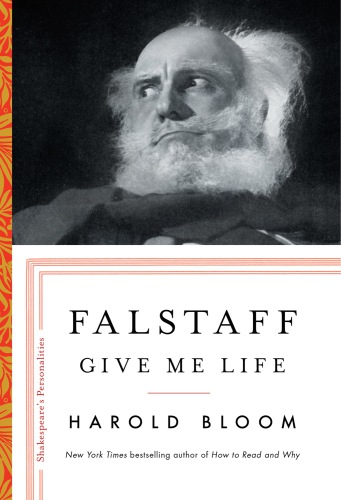
Falstaff
Give Me Life
کتاب های مرتبط
- اطلاعات
- نقد و بررسی
- دیدگاه کاربران
نقد و بررسی

February 27, 2017
Famed literary critic and Yale professor Bloom (The Daemon Knows) showcases his favorite Shakespearian character in this poignant work. Falstaff, one of Shakespeare’s most complex tragicomic characters, appears in Henry IV Part One and Part Two and The Merry Wives of Windsor, and is referred to in Henry V. Bloom covers the many facets of a “disreputable and joyous” character, a knight, highwayman, jovial wit, and enthusiastic imbiber of sack (fortified wine) at the Boar’s Head Tavern in London. The book also attends to Falstaff’s motley crew, including Doll Tearsheet, a prostitute; Ancient Pistol, “a street hoodlum”; and Mistress Quickly, the tavern’s malapropism-prone proprietor. Notably, Falstaff is also a nonjudgmental companion to Prince Hal, the son of Henry IV, and Bloom traces their relationship up to Prince Hal’s ultimate rejection and betrayal of Falstaff upon being crowned King Henry V. The author notes that the Henry plays’ historical aspects interest him less than the changing characters of Falstaff and, to a lesser extent, Hal. Bloom, who says he fell in love with Falstaff because “he exposes what is counterfeit in me and in all others,” has created a larger-than-life portrait of a flawed character who is “at his best a giant image of human freedom.” Agent: Glen Hartley, Writers’ Representatives.

February 1, 2017
An ardent admirer of Shakespeare analyzes an incomparably robust character.For esteemed literary critic Bloom (Humanities/Yale Univ.; The Daemon Knows: Literary Greatness and the American Sublime, 2015, etc.), MacArthur Fellow and winner of multiple awards and honorary degrees, Shakespeare's Sir John Falstaff has enduring appeal, a character who "springs to life" anew each time he is read or seen on stage. Falstaff, Bloom asserts, "is as bewildering as Hamlet, as infinitely varied as Cleopatra." Unlike the beleaguered, grieving prince or the Egyptian queen, however, Falstaff appears in plays not as frequently performed: Shakespeare's trilogy of Henry plays. Bloom, though, assumes his readers--like students who have done their assignments--are as cognizant of these plays as he is. In 21 chapters, he analyzes excerpts from the plays to support his argument that the ribald Falstaff is life-affirming, "everliving," and "the greatest wit in literature." Bloom, now 86, feeling some diminishment with age, is buoyed by Falstaff, who "resolutely remains a child" and "finds fresh delight in play." Bloom gained some insight into the character when he performed the role with the American Repertory Theatre in Cambridge, Massachusetts, in 2000 and at Yale, and he has seen a host of notable actors take it on. He especially admires the interpretations of Ralph Richardson, who played Falstaff with "a wounded dignity," and Orson Welles, who "relished the goodness of every phrase" that Falstaff spoke, "tasting it as if it were bread and wine." Of all Shakespeare's characters, Falstaff and Hamlet seem to Bloom "as being creations nearest" to the "concealed inwardness" of the playwright. Indeed, he writes, "it is difficult for me to withstand the temptation of identifying the Fat Knight with Shakespeare himself." In this first of five books about Shakespearean personalities, Bloom brings erudition and boundless enthusiasm.
COPYRIGHT(2017) Kirkus Reviews, ALL RIGHTS RESERVED.

April 1, 2017
Shakespearean scholar Bloom (Sterling Professor of Humanities, Yale Univ.; Berg Professor of English, NYU; Shakespeare: The Invention of the Human) fits many treasures into a scant number of pages in what is first and foremost a moving personal appreciation of what Bloom considers Shakespeare's most complete and effective character, Sir John Falstaff. The errant knight gets his due in Bloom's moving description of how Shakespeare's invention touched his life from adolescence on. In addition, the reader is treated to a close reading of Falstaff in the histories (his appearance in The Merry Wives of Windsor is mercifully glossed over). Part of this analysis is devoted to the characters in the Henriad (newly dubbed "the Falstaffiad" in this study) who echo Sir John. Hotspur, Hal, and Henry IV are all viewed through the prism of the corpulent crusader and the insights are solid, if not revolutionary. Bloom also devotes his attention to Falstaff in performance. Using Ralph Richardson's legendary enactment at the Old Vic and Orson Welles in his neglected masterpiece Chimes at Midnight, Bloom demonstrates how the plays work not just on the page but in the theater. VERDICT An enchanting and appreciative celebration of Shakespeare's greatest comic creation.--John Frank, Los Angeles P.L.
Copyright 2017 Library Journal, LLC Used with permission.

























دیدگاه کاربران